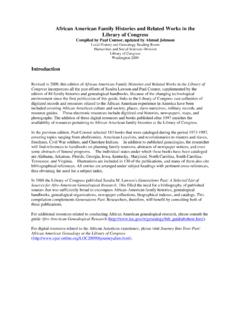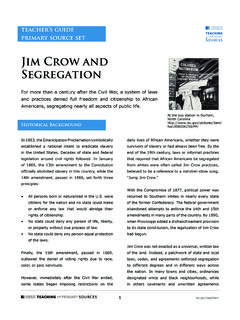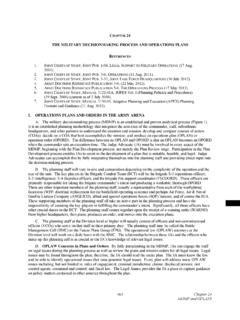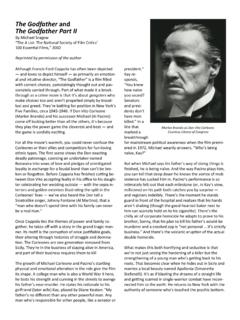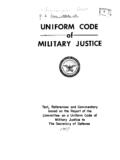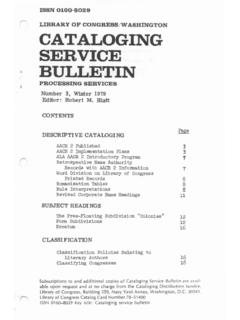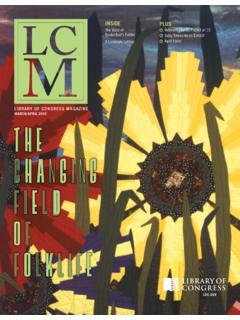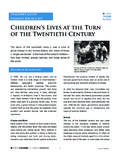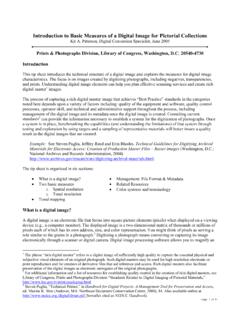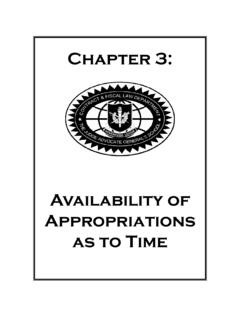Transcription of Country Profile: Philippines - Library of Congress
1 Library of Congress Federal Research Division Country profile : Philippines , March 2006 1 Country profile : Philippines March 2006 Click to Enlarge Image Country Formal Name: Republic of the Philippines (Republika ng Pilipinas). Short Form: Philippines (Pilipinas). Term for Citizen(s): Filipino(s). Capital: Manila. Major Cities: Located on Luzon Island, Metropolitan Manila, including the adjacent Quezon City and surrounding suburbs, is the largest city in the Philippines , with about 12 million people, or nearly 14 percent of the total population. Other large cities include Cebu City on Cebu Island and Davao City on Mindanao Island. Independence: The Philippines attained independence from Spain on June 12, 1898, and from the United States on July 4, 1946. Public Holidays: New Year s Day (January 1), Holy Thursday (also called Maundy Thursday, movable date in March or April), Good Friday (movable date in March or April), Araw ng Kagitingan (Day of Valor, commonly called Bataan Day outside of the Philippines , April 9), Labor Day (May 1), Independence Day (June 12), National Heroes Day (last Sunday of August), Bonifacio Day (celebration of the birthday of Andres Bonifacio, November 30), Eid al Fitr (the last day of Ramadan, movable date), Christmas Day (December 25), Rizal Day (the date of the execution by the Spanish of Jos Rizal in 1896, December 30).
2 Flag: The flag of the Philippines has two equal horizontal bands of blue Click to Enlarge Image(top) and red with a white equilateral triangle based on the hoist side; in the center of the triangle is a yellow sun with eight primary rays (each containing three individual rays), and in each corner of the triangle is a small yellow five-pointed star. HISTORICAL BACKGROUND Early History: The philippine archipelago was settled at least 30,000 years ago, when migrations from the Indonesian archipelago and elsewhere are believed to have occurred. Additional migrations took place over the next millennia. Over time, social and political organization developed and evolved in the widely scattered islands. The basic unit of settlement was the barangay (a Malay word for boat that came to be used to denote a communal settlement). Kinship groups were led by a datu (chief), and within the barangay there were broad Library of Congress Federal Research Division Country profile : Philippines , March 2006 2social divisions consisting of nobles, freemen, and dependent and landless agricultural workers and slaves.
3 Over the centuries, Indo-Malay migrants were joined by Chinese traders. A major development in the early period was the introduction of Islam to the Philippines by traders and proselytizers from the Indonesian islands. By 1500, Islam had been established in the Sulu Archipelago and spread from there to Mindanao; it reached the Manila area by 1565. In the midst of the introduction of Islam came the introduction of Christianity, with the arrival of the Spanish. Spanish Control: Ferdinand Magellan was the first European recorded to have landed in the Philippines . He arrived in March 1521 during his circumnavigation of the globe. He claimed land for the king of Spain but was killed by a local chief. Following several more Spanish expeditions, the first permanent settlement was established in Cebu in 1565. After defeating a local Muslim ruler, the Spanish set up their capital at Manila in 1571, and they named their new colony after King Philip II of Spain.
4 In doing so, the Spanish sought to acquire a share in the lucrative spice trade, develop better contacts with China and Japan, and gain converts to Christianity. Only the third objective was eventually realized. As with other Spanish colonies, church and state became inseparably linked in carrying out Spanish objectives. Several Roman Catholic religious orders were assigned the responsibility of Christianizing the local population. The civil administration built upon the traditional village organization and used traditional local leaders to rule indirectly for Spain. Through these efforts, a new cultural community was developed, but Muslims (known as Moros by the Spanish) and upland tribal peoples remained detached and alienated. Trade in the Philippines centered around the Manila galleons, which sailed from Acapulco on the west coast of Mexico (New Spain) with shipments of silver bullion and minted coin that were exchanged for return cargoes of Chinese goods, mainly silk textiles and porcelain.
5 There was no direct trade with Spain and little exploitation of indigenous natural resources. Most investment was in the galleon trade. But, as this trade thrived, another unwelcome element was introduced sojourning Chinese entrepreneurs and service providers. During the Seven Years War (1756 63), British East India Company forces captured Manila. Although the Philippines was returned to Spain at the end of the war, the British occupation marked the beginning of the end of the old order. Rebellions broke out in the north, and while the Spanish were busy fighting the British, Moros raided from the south. The Chinese community, resentful of Spanish discrimination, supported the British with laborers and armed men. The restoration of Spanish rule brought reforms aimed at promoting the economic development of the islands and making them independent of subsidies from New Spain. The galleon trade ceased in 1815, and from that date onward the Royal Company of the Philippines , which had been chartered in 1785, promoted direct and tariff-free trade between the islands and Spain.
6 Cash crops were cultivated for trade with Europe and Latin America, but profits diminished after Spain s Latin American colonies became independent in the 1810s and 1820s. In 1834 the Royal Company of the Philippines was abolished, and free trade was formally recognized. With its excellent harbor, Manila became an open port for Asian, European, and North American traders. In 1873 additional ports were opened to foreign commerce, and by the late nineteenth century three crops tobacco, abaca, and sugar dominated philippine exports. Library of Congress Federal Research Division Country profile : Philippines , March 2006 3 Rise of Nationalism: Also in the late nineteenth century, Chinese immigration, now with official approval, increased, and Chinese mestizos became a feature in Filipino social and economic life. So, too, did the growing Filipino native elite class of ilustrados (literally, enlightened ones), who became increasingly receptive to liberal and democratic ideas.
7 Conservative Catholic friars continued to dominate the Spanish establishment, however. They resisted the inclusion of native clergy and were economically secure, with their large land holdings and control of churches, schools, and other establishments. Despite the bias against native priests, brothers, and nuns, some members of Filipino religious orders became prominent to the point of leading local religious movements and even insurrections against the establishment. Additionally, ilustrados returning from education and exile abroad brought new ideas that merged with folk religion to spur a national resistance. One of the early nationalist leaders was Jos Rizal, a physician, scientist, scholar, and writer. His writings as a member of the Propaganda Movement (intellectually active, upper-class Filipino reformers) had a considerable impact on the awakening of the Filipino national consciousness. His books were banned, and he lived in self-imposed exile.
8 Rizal returned from overseas in 1892 to found the Liga Filipina ( philippine League), a national, nonviolent political organization, but he was arrested and exiled and the league dissolved. One result was the split of the nationalist movement between the reform-minded ilustrados and a more revolutionary and independence-minded plebeian constituency. Many of the latter joined the Katipunan, a secret society founded by Andres Bonifacio in 1892 and committed to winning national independence. By 1896, the year the Katipunan rose in revolt against Spain, it had 30,000 members. Although Rizal, who had again returned to the Philippines , was not a member of the Katipunan, he was arrested and executed on December 30, 1896, for his alleged role in the rebellion. With Rizal s martyrdom, the rebels, led by Emilio Aguinaldo as president, were filled with new determination. Spanish troops defeated the insurgents, however, and Aguinaldo and his government went into exile in Hong Kong in December 1897.
9 When the Spanish-American War broke out in April 1898, Spain s fleet was easily defeated at Manila. Aguinaldo returned, and his 12,000 troops kept the Spanish forces bottled up in Manila until troops landed. The Spanish cause was doomed, but the Americans did nothing to accommodate the inclusion of Aguinaldo in the succession. Fighting between American and Filipino troops broke out almost as soon as the Spanish had been defeated. Aguinaldo issued a declaration of independence on June 12, 1898. However, the Treaty of Paris, signed on December 10, 1898, by the United States and Spain, ceded the Philippines , Guam, and Puerto Rico to the United States, recognized Cuban independence, and gave US$20 million to Spain. A revolutionary Congress convened at Malolos, north of Manila, promulgated a constitution on January 21, 1899, and inaugurated Aguinaldo as president of the new republic two days later. Hostilities broke out in February 1899, and by March 1901 Aguinaldo had been captured and his forces defeated.
10 Despite Aguinaldo s call to his compatriots to lay down their arms, insurgent resistance continued until 1903. The Moros, suspicious of both the Christian Filipino insurgents and the Americans, remained largely neutral, but eventually their own armed resistance had to be subjugated, and Moro territory was placed under military rule until 1914. United States Rule: rule over the Philippines had two phases. The first phase was from 1898 to 1935, during which time Washington defined its colonial mission as one of tutelage and Library of Congress Federal Research Division Country profile : Philippines , March 2006 4preparing the Philippines for eventual independence. Political organizations developed quickly, and the popularly elected philippine Assembly (lower house) and the philippine Commission (upper house) served as a bicameral legislature. The ilustrados formed the Federalista Party, but their statehood platform had limited appeal.
